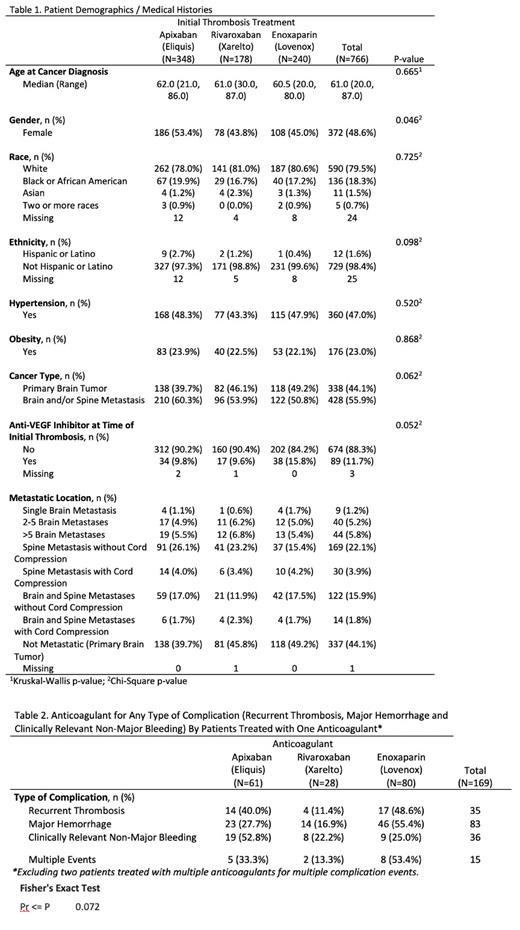Introduction: In the last decade, landmark studies have been conducted in patients with cancer-associated venous thromboembolism (CA-VTE), helping to guide treatment decisions of anticoagulant therapy. Although these trials outlined new treatment opportunities, they either completely excluded or included only a small number of patients with primary brain tumors or central nervous system (CNS) metastasis. Additionally, there are very limited data on complication rates of anticoagulants in patients with spinal metastasis. Consequently, there is an ongoing knowledge gap for safe and effective anticoagulation options for patients with acute VTE in this high-risk patient population.
Methods: We conducted a single institution IRB-approved retrospective study evaluating the rates of hemorrhage and recurrent thromboses in patients with CA-VTE and a diagnosis of a primary brain tumor or brain and/or spinal metastases. Our investigation was conducted at The Preston Robert Tisch Brain Tumor Center and the Center for Brain and Spine Metastasis at Duke between 2017 and 2021. The cohort was built through identifying patients by ICD-10 codes searched within the electronic medical records. Inclusion criteria consisted of patients ≥ 18 years of age, a history of confirmed primary brain tumor or brain and/or spinal metastases prior to VTE, treatment with anticoagulation or an inferior vena cava (IVC) filter, and followed up at least once since starting treatment beyond 1 month of VTE diagnosis . We compared complication event rates and the anticoagulant selected for treatment. Data obtained included patient demographic information, medical and social histories, cancer-related history, VTE history and treatment, recurrent thrombotic and hemorrhagic events, and patient mortality.
Results: We identified 3584 total patients during the study timeframe. Eight hundred and twenty-five patients were included and 2759 were excluded for not meeting our inclusion criteria. Of the 825 included patients, 766 were treated with either apixaban (348/766; 45%), rivaroxaban (178/766; 23%), or enoxaparin (240/766; 31%) for their initial CA-VTE (Table 1). The other 59 patients were treated with another anticoagulant or received an IVC filter without anticoagulation. The median age for our cohort of 766 patients was 61.0 (20.0 - 87.0). There was no significant statistical association between relevant past medical histories of obesity or hypertension among the 3 anticoagulant groups. There was no significant statistical association between the 3 anticoagulant cohorts and primary brain tumors, or brain and/or spinal metastases ( p= 0.06). Although it trended towards significance, there was no statistically significant difference in the proportion of patients receiving anti-VEGF inhibitors at time of initial VTE among the 3 anticoagulant cohorts ( p = 0.052). When looking at our primary outcomes of recurrent thrombosis, major hemorrhage, or clinically relevant non-major bleeding, 171 individual patients experienced a total of 188 unique events that occurred during treatment with apixaban, rivaroxaban, or enoxaparin (Table 2). Of the 171 unique patients, enoxaparin use was the most common (80/171; 47%), followed by apixaban (61/171; 36%), rivaroxaban (28/171; 16%), and a small percentage (2/171; 1%) were treated with a combination of apixaban, rivaroxaban, or enoxaparin during their unique event. When excluding the 2 patients with multiple anticoagulant treatments, there was no statistical difference among anticoagulant rates and any event of recurrent thrombosis, major hemorrhage, clinically relevant non-major bleeding, or any multiple events ( p = 0.07).
Conclusions: We present the largest unique data set comparing anticoagulant use in a known high-risk patient population of primary brain tumors, brain and/or spinal metastases. Our data demonstrate up to 22% of patients with CA-VTE and primary brain tumors, brain and/or spinal metastases have a subsequent hemorrhagic or recurrent thrombotic complication during treatment with apixaban, rivaroxaban, or enoxaparin for their initial event. However, our data did not demonstrate a statistically significant difference in complication rates between these 3 anticoagulants. These findings indicate a need for future large-scale prospective investigations to determine optimal treatment in this high-risk patient population.
Disclosures
Ortel:NIH: Research Funding; CDC: Research Funding; Sanofi: Consultancy; Stago: Research Funding; Siemens: Research Funding; UpToDate: Honoraria; Takeda: Research Funding; Instrumentation Laboratory: Consultancy, Research Funding.


This feature is available to Subscribers Only
Sign In or Create an Account Close Modal